Weiwei Cui
Auto-Test: Learning Semantic-Domain Constraints for Unsupervised Error Detection in Tables
Apr 14, 2025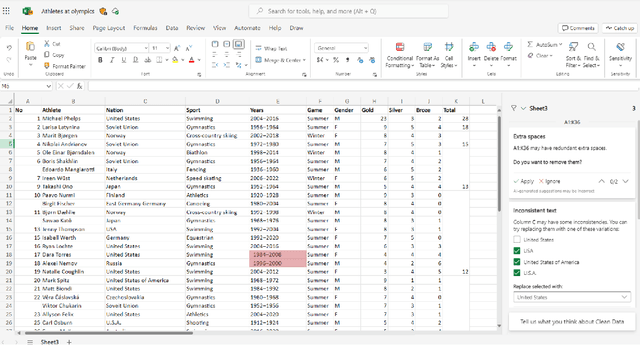



Abstract:Data cleaning is a long-standing challenge in data management. While powerful logic and statistical algorithms have been developed to detect and repair data errors in tables, existing algorithms predominantly rely on domain-experts to first manually specify data-quality constraints specific to a given table, before data cleaning algorithms can be applied. In this work, we propose a new class of data-quality constraints that we call Semantic-Domain Constraints, which can be reliably inferred and automatically applied to any tables, without requiring domain-experts to manually specify on a per-table basis. We develop a principled framework to systematically learn such constraints from table corpora using large-scale statistical tests, which can further be distilled into a core set of constraints using our optimization framework, with provable quality guarantees. Extensive evaluations show that this new class of constraints can be used to both (1) directly detect errors on real tables in the wild, and (2) augment existing expert-driven data-cleaning techniques as a new class of complementary constraints. Our extensively labeled benchmark dataset with 2400 real data columns, as well as our code are available at https://github.com/qixuchen/AutoTest to facilitate future research.
ReSpark: Leveraging Previous Data Reports as References to Generate New Reports with LLMs
Feb 04, 2025Abstract:Creating data reports is time-consuming, as it requires iterative exploration and understanding of data, followed by summarizing the insights. While large language models (LLMs) are powerful tools for data processing and text generation, they often struggle to produce complete data reports that fully meet user expectations. One significant challenge is effectively communicating the entire analysis logic to LLMs. Moreover, determining a comprehensive analysis logic can be mentally taxing for users. To address these challenges, we propose ReSpark, an LLM-based method that leverages existing data reports as references for creating new ones. Given a data table, ReSpark searches for similar-topic reports, parses them into interdependent segments corresponding to analytical objectives, and executes them with new data. It identifies inconsistencies and customizes the objectives, data transformations, and textual descriptions. ReSpark allows users to review real-time outputs, insert new objectives, and modify report content. Its effectiveness was evaluated through comparative and user studies.
STS MICCAI 2023 Challenge: Grand challenge on 2D and 3D semi-supervised tooth segmentation
Jul 18, 2024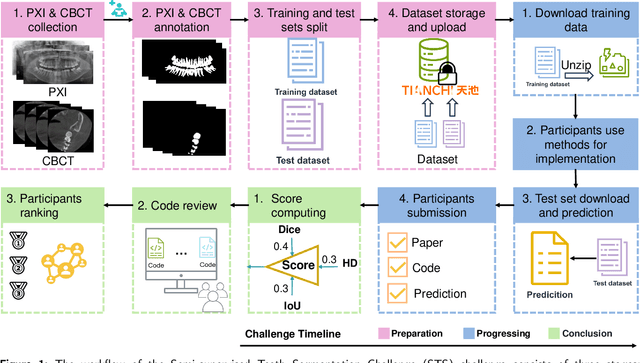


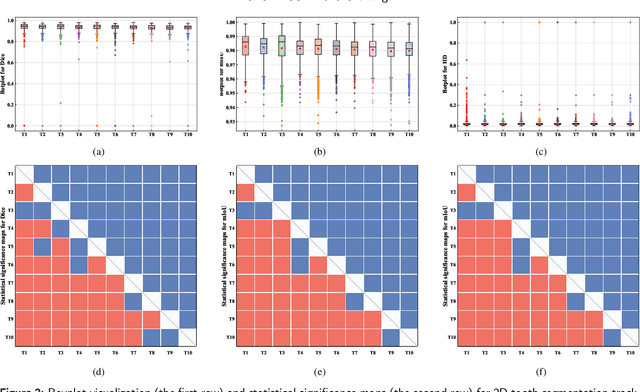
Abstract:Computer-aided design (CAD) tools are increasingly popular in modern dental practice, particularly for treatment planning or comprehensive prognosis evaluation. In particular, the 2D panoramic X-ray image efficiently detects invisible caries, impacted teeth and supernumerary teeth in children, while the 3D dental cone beam computed tomography (CBCT) is widely used in orthodontics and endodontics due to its low radiation dose. However, there is no open-access 2D public dataset for children's teeth and no open 3D dental CBCT dataset, which limits the development of automatic algorithms for segmenting teeth and analyzing diseases. The Semi-supervised Teeth Segmentation (STS) Challenge, a pioneering event in tooth segmentation, was held as a part of the MICCAI 2023 ToothFairy Workshop on the Alibaba Tianchi platform. This challenge aims to investigate effective semi-supervised tooth segmentation algorithms to advance the field of dentistry. In this challenge, we provide two modalities including the 2D panoramic X-ray images and the 3D CBCT tooth volumes. In Task 1, the goal was to segment tooth regions in panoramic X-ray images of both adult and pediatric teeth. Task 2 involved segmenting tooth sections using CBCT volumes. Limited labelled images with mostly unlabelled ones were provided in this challenge prompt using semi-supervised algorithms for training. In the preliminary round, the challenge received registration and result submission by 434 teams, with 64 advancing to the final round. This paper summarizes the diverse methods employed by the top-ranking teams in the STS MICCAI 2023 Challenge.
Auto-Formula: Recommend Formulas in Spreadsheets using Contrastive Learning for Table Representations
Apr 19, 2024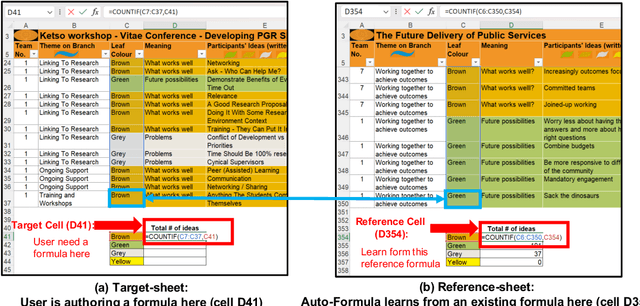

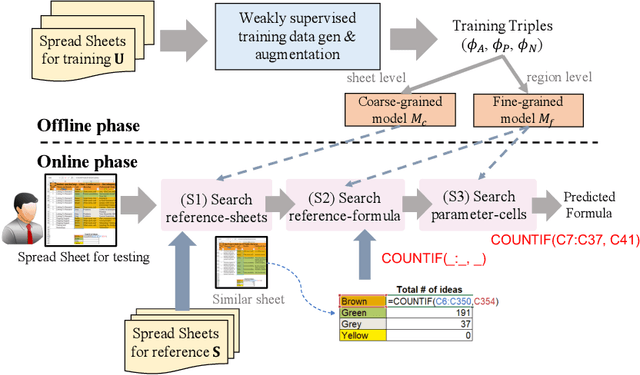

Abstract:Spreadsheets are widely recognized as the most popular end-user programming tools, which blend the power of formula-based computation, with an intuitive table-based interface. Today, spreadsheets are used by billions of users to manipulate tables, most of whom are neither database experts nor professional programmers. Despite the success of spreadsheets, authoring complex formulas remains challenging, as non-technical users need to look up and understand non-trivial formula syntax. To address this pain point, we leverage the observation that there is often an abundance of similar-looking spreadsheets in the same organization, which not only have similar data, but also share similar computation logic encoded as formulas. We develop an Auto-Formula system that can accurately predict formulas that users want to author in a target spreadsheet cell, by learning and adapting formulas that already exist in similar spreadsheets, using contrastive-learning techniques inspired by "similar-face recognition" from compute vision. Extensive evaluations on over 2K test formulas extracted from real enterprise spreadsheets show the effectiveness of Auto-Formula over alternatives. Our benchmark data is available at https://github.com/microsoft/Auto-Formula to facilitate future research.
Table-GPT: Table-tuned GPT for Diverse Table Tasks
Oct 13, 2023Abstract:Language models, such as GPT-3.5 and ChatGPT, demonstrate remarkable abilities to follow diverse human instructions and perform a wide range of tasks. However, when probing language models using a range of basic table-understanding tasks, we observe that today's language models are still sub-optimal in many table-related tasks, likely because they are pre-trained predominantly on \emph{one-dimensional} natural-language texts, whereas relational tables are \emph{two-dimensional} objects. In this work, we propose a new "\emph{table-tuning}" paradigm, where we continue to train/fine-tune language models like GPT-3.5 and ChatGPT, using diverse table-tasks synthesized from real tables as training data, with the goal of enhancing language models' ability to understand tables and perform table tasks. We show that our resulting Table-GPT models demonstrate (1) better \emph{table-understanding} capabilities, by consistently outperforming the vanilla GPT-3.5 and ChatGPT, on a wide-range of table tasks, including holdout unseen tasks, and (2) strong \emph{generalizability}, in its ability to respond to diverse human instructions to perform new table-tasks, in a manner similar to GPT-3.5 and ChatGPT.
Auto-Validate by-History: Auto-Program Data Quality Constraints to Validate Recurring Data Pipelines
Jun 04, 2023



Abstract:Data pipelines are widely employed in modern enterprises to power a variety of Machine-Learning (ML) and Business-Intelligence (BI) applications. Crucially, these pipelines are \emph{recurring} (e.g., daily or hourly) in production settings to keep data updated so that ML models can be re-trained regularly, and BI dashboards refreshed frequently. However, data quality (DQ) issues can often creep into recurring pipelines because of upstream schema and data drift over time. As modern enterprises operate thousands of recurring pipelines, today data engineers have to spend substantial efforts to \emph{manually} monitor and resolve DQ issues, as part of their DataOps and MLOps practices. Given the high human cost of managing large-scale pipeline operations, it is imperative that we can \emph{automate} as much as possible. In this work, we propose Auto-Validate-by-History (AVH) that can automatically detect DQ issues in recurring pipelines, leveraging rich statistics from historical executions. We formalize this as an optimization problem, and develop constant-factor approximation algorithms with provable precision guarantees. Extensive evaluations using 2000 production data pipelines at Microsoft demonstrate the effectiveness and efficiency of AVH.
CTooth+: A Large-scale Dental Cone Beam Computed Tomography Dataset and Benchmark for Tooth Volume Segmentation
Aug 02, 2022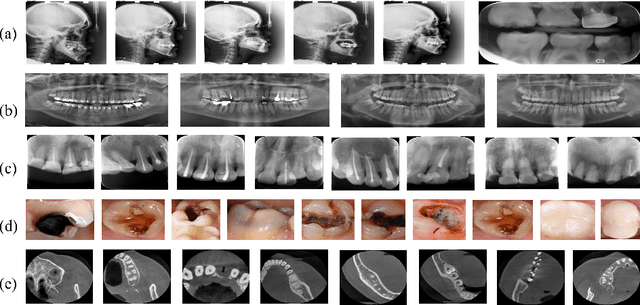

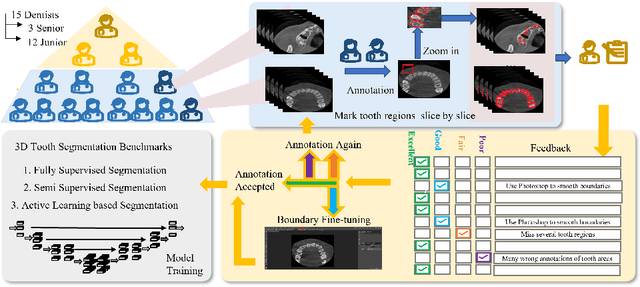

Abstract:Accurate tooth volume segmentation is a prerequisite for computer-aided dental analysis. Deep learning-based tooth segmentation methods have achieved satisfying performances but require a large quantity of tooth data with ground truth. The dental data publicly available is limited meaning the existing methods can not be reproduced, evaluated and applied in clinical practice. In this paper, we establish a 3D dental CBCT dataset CTooth+, with 22 fully annotated volumes and 146 unlabeled volumes. We further evaluate several state-of-the-art tooth volume segmentation strategies based on fully-supervised learning, semi-supervised learning and active learning, and define the performance principles. This work provides a new benchmark for the tooth volume segmentation task, and the experiment can serve as the baseline for future AI-based dental imaging research and clinical application development.
CTooth: A Fully Annotated 3D Dataset and Benchmark for Tooth Volume Segmentation on Cone Beam Computed Tomography Images
Jun 17, 2022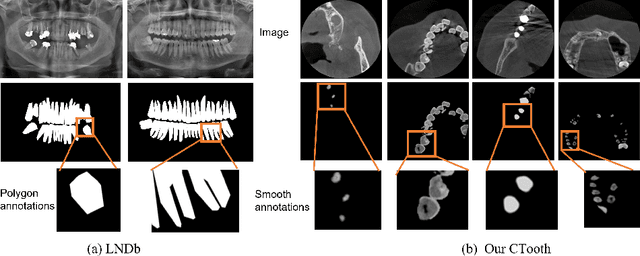


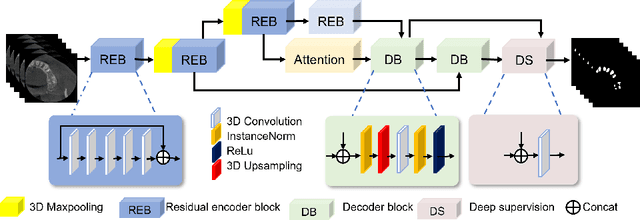
Abstract:3D tooth segmentation is a prerequisite for computer-aided dental diagnosis and treatment. However, segmenting all tooth regions manually is subjective and time-consuming. Recently, deep learning-based segmentation methods produce convincing results and reduce manual annotation efforts, but it requires a large quantity of ground truth for training. To our knowledge, there are few tooth data available for the 3D segmentation study. In this paper, we establish a fully annotated cone beam computed tomography dataset CTooth with tooth gold standard. This dataset contains 22 volumes (7363 slices) with fine tooth labels annotated by experienced radiographic interpreters. To ensure a relative even data sampling distribution, data variance is included in the CTooth including missing teeth and dental restoration. Several state-of-the-art segmentation methods are evaluated on this dataset. Afterwards, we further summarise and apply a series of 3D attention-based Unet variants for segmenting tooth volumes. This work provides a new benchmark for the tooth volume segmentation task. Experimental evidence proves that attention modules of the 3D UNet structure boost responses in tooth areas and inhibit the influence of background and noise. The best performance is achieved by 3D Unet with SKNet attention module, of 88.04 \% Dice and 78.71 \% IOU, respectively. The attention-based Unet framework outperforms other state-of-the-art methods on the CTooth dataset. The codebase and dataset are released.
DeepDrawing: A Deep Learning Approach to Graph Drawing
Jul 27, 2019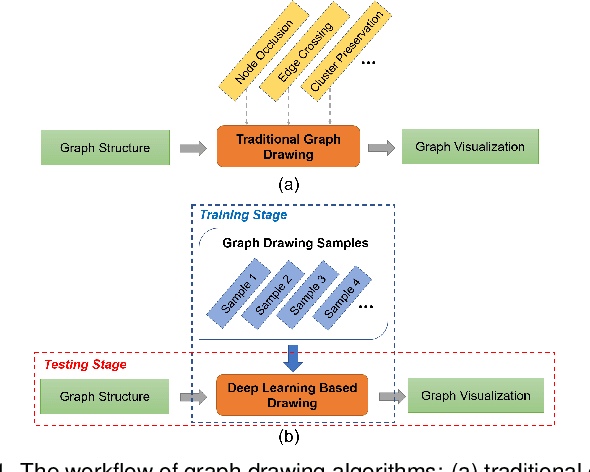

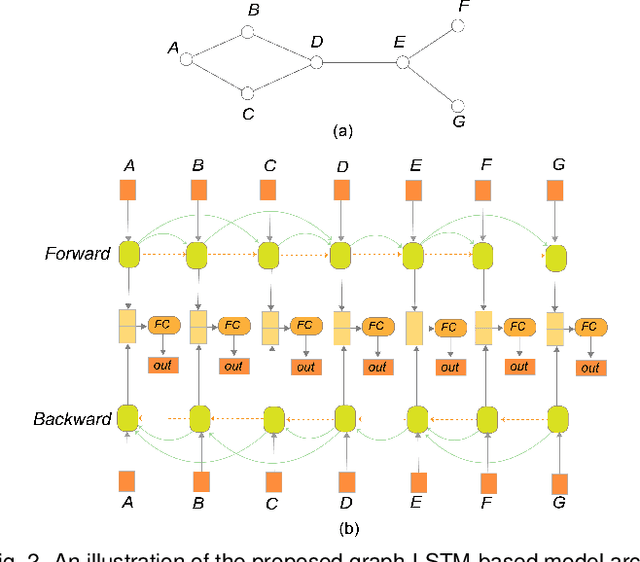

Abstract:Node-link diagrams are widely used to facilitate network explorations. However, when using a graph drawing technique to visualize networks, users often need to tune different algorithm-specific parameters iteratively by comparing the corresponding drawing results in order to achieve a desired visual effect. This trial and error process is often tedious and time-consuming, especially for non-expert users. Inspired by the powerful data modelling and prediction capabilities of deep learning techniques, we explore the possibility of applying deep learning techniques to graph drawing. Specifically, we propose using a graph-LSTM-based approach to directly map network structures to graph drawings. Given a set of layout examples as the training dataset, we train the proposed graph-LSTM-based model to capture their layout characteristics. Then, the trained model is used to generate graph drawings in a similar style for new networks. We evaluated the proposed approach on two special types of layouts (i.e., grid layouts and star layouts) and two general types of layouts (i.e., ForceAtlas2 and PivotMDS) in both qualitative and quantitative ways. The results provide support for the effectiveness of our approach. We also conducted a time cost assessment on the drawings of small graphs with 20 to 50 nodes. We further report the lessons we learned and discuss the limitations and future work.
DeepTracker: Visualizing the Training Process of Convolutional Neural Networks
Aug 26, 2018
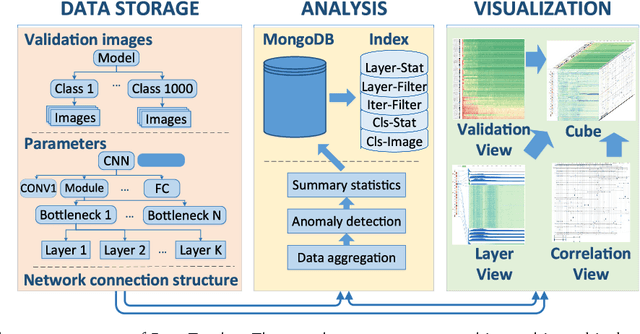
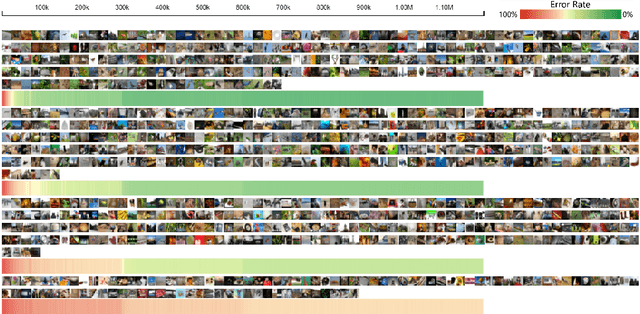

Abstract:Deep convolutional neural networks (CNNs) have achieved remarkable success in various fields. However, training an excellent CNN is practically a trial-and-error process that consumes a tremendous amount of time and computer resources. To accelerate the training process and reduce the number of trials, experts need to understand what has occurred in the training process and why the resulting CNN behaves as such. However, current popular training platforms, such as TensorFlow, only provide very little and general information, such as training/validation errors, which is far from enough to serve this purpose. To bridge this gap and help domain experts with their training tasks in a practical environment, we propose a visual analytics system, DeepTracker, to facilitate the exploration of the rich dynamics of CNN training processes and to identify the unusual patterns that are hidden behind the huge amount of training log. Specifically,we combine a hierarchical index mechanism and a set of hierarchical small multiples to help experts explore the entire training log from different levels of detail. We also introduce a novel cube-style visualization to reveal the complex correlations among multiple types of heterogeneous training data including neuron weights, validation images, and training iterations. Three case studies are conducted to demonstrate how DeepTracker provides its users with valuable knowledge in an industry-level CNN training process, namely in our case, training ResNet-50 on the ImageNet dataset. We show that our method can be easily applied to other state-of-the-art "very deep" CNN models.
 Add to Chrome
Add to Chrome Add to Firefox
Add to Firefox Add to Edge
Add to Edge